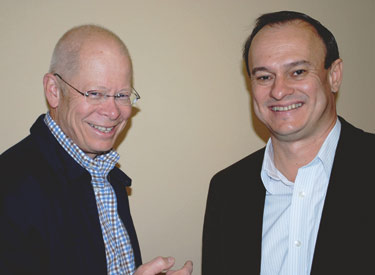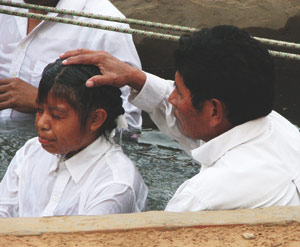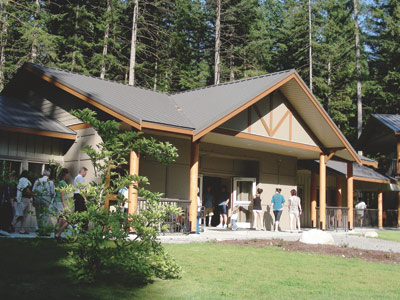Canadian Mennonite
Volume 13, No. 20
Oct. 19, 2009
From north to south, the torch is passed
Ernst Bergen of Paraguay assumes role of MWC treasurer
Asunción, Paraguay
 |
Think twice if you assume that either the outgoing or incoming Mennonite World Conference (MWC) treasurer is concerned only with the organization’s balance sheet.
American Paul Quiring wrapped up his 11-year tenure as treasurer at this summer’s MWC assembly. In his final days, he wanted to talk only about MWC’s future and how that is already affecting its finances.
“Mennonite World Conference is not a maintenance operation,” he said. “It’s a growing, visioning operation. Ernst Bergen, the newly appointed treasurer, is right for that. A whole new chapter is opening in MWC.
“Many North American agencies are dealing with their own pasts,” Quiring continued. “This organization isn’t concerned with that. It’s about the future, about young people and their vision. The treasurer’s responsibilities are going into hands of the highest calibre.”
Bergen became MWC’s newest treasurer at the close of the 2009 MWC assembly, and its first from the global South. In his mid-40s, Bergen has served in Paraguay’s presidential cabinet and is now an advisor to a variety of Paraguayan businesses.
“The invitation to this responsibility was a complete surprise,” he said. “I started praying; I talked with my family; I talked to my pastor; I placed the matter before our church conference leadership. They all advised and encouraged me to do it. I do have enthusiasm for this and a deep internal peace about it.
“I see that the churches have a considerable love of MWC,” Bergen said, adding, “The challenge for us in leadership is to be in tune with God and to be willing to act in accord with what we perceive God wants us to do. It is also our task to help our members to understand MWC’s work, to go to them and to ask for their support.”
One of Bergen’s personal projects is “Good Governance,” which offers chaplaincy services to Paraguayans in public office. Upon observing Bergen’s involvement with this program, MWC’s general secretary Larry Miller commented, “This guy knows how to lead from behind.”
Bergen believes that the provision within MWC’s new constitution, which encourages the development of continental MWC offices, is an effort where growth and effective accompaniment can happen. “MWC is financially sustainable and absolutely viable,” he said. “I am convinced that both MWC and its funding can grow. Finances must stay in balance and proportion with MWC’s activities. Money will follow MWC’s presence and life.”
Personal Reflection
Ashamed, but hopeful in Christ
 |
Usually I take pride in being a Christian. But occasionally I hang my head in utter shame and even horror at what the church has done, and I plead with God to never again allow us, the church today, to make some of the world-changing mistakes we have made in the past.
The aboriginal learning tour following the Mennonite World Conference assembly in Paraguay was such an experience. It was an incredibly unique, diverse and intergenerational group. Métis, Ojibway, Cheyenne, Cree, Shawnee and Lakota from North America joined different tribal groups from Guatemala, Panama and Peru. This group—communicating bilingually in English and Spanish—was hosted by the Enlhet, Nivaclé and Guarani indigenous Mennonites in Paraguay, and Toba Qom and Mocoví Christians from Argentina.
As the conversations deepened between cultures, common themes emerged. This is where I found myself both impressed by the consistently gracious spirit of all the groups, and increasingly sickened by the role of the church in committing what some have come to call cultural genocide. The church has had a huge role, both as accomplice and perpetrator, of the systematic degradation, devaluation and near obliteration of indigenous cultures, traditions and sense of peoplehood of Aboriginal Peoples in all of the Americas.
It was clear that every single group represented continues to experience the effects of this attempted obliteration of their cultures. While not every group has experienced a residential school type policy, each actively struggles with its sense of peoplehood; of being the victims of broad sweeping repression and overt oppression, and specific laws that marginalize them; as well as resultant effects of all forms of abuse at the hands of colonizers, governments, and, yes, the church.
In Canada, government-funded, church-run residential schools were, in the words of Deputy Superintendent of Indian Affairs Duncan Campbell Scott (1923-32), a key strategy to getting rid “of the Indian problem.” After working in the Canadian civil service since 1879, Scott summed up over a century of past and future policy when, in 1920, he stated that “our objective is to continue until there is not a single Indian in Canada that has not been absorbed into the body politic, and there is no Indian question and no Indian department.”
In all, 150,000 Canadian aboriginal children were forcibly removed from their homes, families and communities, and required to attend residential schools in order to educate them in English, instill “Christian” values in them, and systematically remove their culture, values, traditions and languages from them. In effect, significant, sustained effort was made to force aboriginal Canadians to be less than they are as children created in the image of God.
Yet as I sat with aboriginal brothers and sisters, listening to their conversations, I was in awe at the hope they showed, and the grace and forgiveness they embodied. In spite of the church, here we were at a global church event. In spite of the degrading treatment and abuse administered at the hands of the church, we all joined hands to pray and sing praises to God. In spite of the fact that they all are struggling to pass on their language and music, they welcomed and accepted us as non-aboriginal brothers and sisters in their midst.
In the closing session, several people stated that this encounter made them realize that they can be proud to be Métis, Toba or Quechua. One South American brother challenged the others to claim a healthy attitude in Christ, looking to Christ as our Creator, accepting that we are made in the image of God and thus can be proud and strong in Christ, rather than feeling poor, victimized and without opportunity.
I hung my head in shame at what the church has done and the pain it has inflicted. And then I raised my head, as if Christ himself were lifting my chin. And I looked into the eyes of my Peruvian aboriginal brother. As we ate a meal together, and shared bread, and he offered to fill my glass, I felt the hope that I saw demonstrated in the participants of this tour.
Lord, forgive us, for we know not what we do. May your kingdom come, your will be done, on earth as it is in heaven.
From generation to generation
As new Camp Squeah lodges are dedicated, the torch is passed from those who have gone before to those still to enjoy this ‘place of refuge’
Hope, B.C.
 |
In a service that began with drumming and singing and concluded with a tree- planting ceremony, the two newest buildings at Camp Squeah were officially dedicated for use on the afternoon of Sept. 13.
The grand opening celebration service for the Emory and Fraser lodges took place exactly 53 weeks after the broken ground had been blessed and construction started in September 2008. The two lodging and retreat centres, named for the nearby Fraser River and Emory Creek, were built with motel-style accommodations with seniors and the mobility-challenged especially in mind.
Mennonite Church B.C. chair Gerd Bartel recalled the first days of Camp Squeah some 48 years ago. He acknowledged several people present who had been there when Camp Squeah opened, and how this building project had resulted from a desire on the part of many in MC B.C. “The dream of the people was supported by the dream of individuals,” he said.
A theme of “From generation to generation” highlighted the legacy of several generations’ involvement through the years at the camp. Pastor Dan Rempel of Cedar Valley Mennonite Church in Mission gave a short meditation on passing on a legacy from one generation to the next. Reflecting on the meaning of the word “Squeah” as “place of refuge,” Rempel called Camp Squeah, “our place to find renewal, to stop and find an opportunity to reflect.”
Concluding the service, participants read a litany together while a sapling was planted beside Emory Lodge and watered by several children (see back cover photo). This ceremony combined dirt collected at the groundbreaking service last year with water drawn from Emory Creek and Fraser River.
The new buildings were then open for a walk-through, showcasing in Fraser Lodge 11 suites containing queen-sized beds, one featuring a kitchenette for pastors or couples who might wish to retreat here for an extended period of time. A beautiful lounge provides the perfect space for 15 to 20 guests to meet, visit and relax.
Emory Lodge, a two-storey building between the camp’s main lodge and gym, has 18 rooms, including three wheelchair-accessible suites and two suites with kitchenettes. The second floor includes three rooms containing six bunk beds apiece, reserved for seasonal staff quarters in spring and fall. The Raven’s Nest is a spacious room containing a full kitchen and common living area, serving in spring as seasonal staff lounge, and ideal for a group of eight to 12 for a cozy and intimate self-catered winter retreat.
A special feature of the Emory Lodge lounge is the Legacy Wall, where a tree stands, its many leaves acknowledging the project’s donors. Rob Tiessen, Camp Squeah’s executive director, describes it as “a space where the next generation of campers will be able to come and be reminded of the many visionaries it took to invest their resources into transforming a dream into reality, a reality to be shared and realized well into the future.”
Thiessen and Bartel both reminded those at the dedication that, although the building phase of the project is complete, there is still ample opportunity to participate in the Generation to Generation campaign: “Partner with us as we aim to pay off the remaining $300,000 loan before year’s end.”